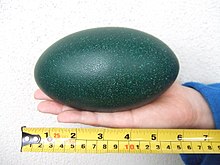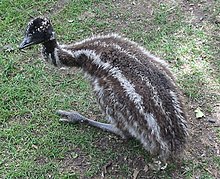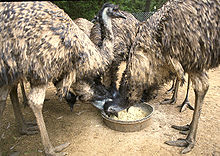Emu
The etymology of the common name "emu" is uncertain, but is thought to have come from an Arabic word for large bird that was later used by Portuguese explorers to describe the related cassowary in Australia and New Guinea.
The legs are stout, formed much as in the Galeated Cassowary, with the addition of their being jagged or sawed the whole of their length at the back part.The species was named by ornithologist John Latham in 1790 based on a specimen from the Sydney area of Australia, a country which was known as New Holland at the time.
[36] Like the cassowary, the emu has sharp claws on its toes which are its major defensive attribute, and are used in combat to inflict wounds on opponents by kicking.
Feathers of emus in more arid areas with red soils have a rufous tint while birds residing in damp conditions are generally darker in hue.
[34] Once common on the east coast of Australia, emus are now uncommon there; by contrast, the development of agriculture and the provision of water for stock in the interior of the continent have increased the range of the emu in arid regions.
[30][33] Emus predominantly travel in pairs, and while they can form large flocks, this is an atypical social behaviour that arises from the common need to move towards a new food source.
A high-intensity boom is audible 2 kilometres (1.2 mi) away, while a low, more resonant call, produced during the breeding season, may at first attract mates and peaks while the male is incubating the eggs.
Their lungs work as evaporative coolers and, unlike some other species, the resulting low levels of carbon dioxide in the blood do not appear to cause alkalosis.
[30] They also eat insects and other arthropods, including grasshoppers and crickets, beetles, cockroaches, ladybirds, bogong and cotton-boll moth larvae, ants, spiders and millipedes.
[50] In Western Australia, food preferences have been observed in travelling emus; they eat seeds from Acacia aneura until the rains arrive, after which they move on to fresh grass shoots and caterpillars; in winter they feed on the leaves and pods of Cassia and in spring, they consume grasshoppers and the fruit of Santalum acuminatum, a sort of quandong.
[51][53] One undesirable effect of this occurred in Queensland in the early twentieth century when emus fed on the fruit of prickly pears in the outback.
Mating usually takes place between April and June; the exact timing is determined by the climate as the birds nest during the coolest part of the year.
When courting, females stride around, pulling their neck back while puffing out their feathers and emitting low, monosyllabic calls that have been compared to drum beats.
[67] If it perceives a threat during this period, it will lie down on top of the nest and try to blend in with the similar-looking surrounds, and suddenly stand up to confront and scare the other party if it comes close.
They stand about 12 cm (5 in) tall at first, weigh 0.5 kg (17.6 oz),[33] and have distinctive brown and cream stripes for camouflage, which fade after three months or so.
The main predator of emus today is the dingo, which was originally introduced by Aboriginals thousands of years ago from a stock of semi-domesticated wolves.
[71] Despite the potential prey-predator relationship, the presence of predaceous dingoes does not appear to heavily influence emu numbers, with other natural conditions just as likely to cause mortality.
Every part of the carcass had some use; the fat was harvested for its valuable, multiple-use oil, the bones were shaped into knives and tools, the feathers were used for body adornment and the tendons substituted for string.
It served as a valuable lubricant, was used to oil wooden tools and utensils such as the coolamon, and was mixed with ochre to make the traditional paint for ceremonial body adornment.
[82] The commercial industry in the country is based on stock bred in captivity, and all states except Tasmania have licensing requirements to protect wild emus.
Outside Australia, emus are farmed on a large scale in North America, with about 1 million birds in the US,[83] Peru, and China, and to a lesser extent in some other countries.
[88][90][91] While there are no scientific studies showing that emu oil is effective in humans, it is marketed and promoted as a dietary supplement with a wide variety of claimed health benefits.
[94][95] They continued longstanding traditions that can be traced back to the European mounted ostrich eggs of the thirteenth century and Christian symbolism and notions of virginity, fertility, faith and strength.
[97] Significant designers Adolphus Blau, Julius Hogarth, Ernest Leviny, Julius Schomburgk, Johann Heinrich Steiner, Christian Quist, Joachim Matthias Wendt, William Edwards and others[98][99] had the technical training on which to build flourishing businesses in a country rich in raw materials and a clientele hungry for old-world paraphernalia.
Many Aboriginal language groups throughout Australia have a tradition that the dark dust lanes in the Milky Way represent a giant emu in the sky.
[114] There are around six hundred gazetted places in Australia with "emu" in their title, including mountains, lakes, hills, plains, creeks and waterholes.
[116] The quarterly peer-reviewed journal of the Royal Australasian Ornithologists Union, also known as Birds Australia, is entitled Emu: Austral Ornithology.
[120] In John Gould's Handbook to the Birds of Australia, first published in 1865, he lamented the loss of the emu from Tasmania, where it had become rare and has since become extinct; he noted that emus were no longer common in the vicinity of Sydney and proposed that the species be given protected status.
[13] In the 1930s, emu killings in Western Australia peaked at 57,000, and culls were also mounted in Queensland during this period due to rampant crop damage.
The threats faced by emus include the clearance and fragmentation of areas of suitable habitat, deliberate slaughter, collisions with vehicles and predation of the eggs and young.















